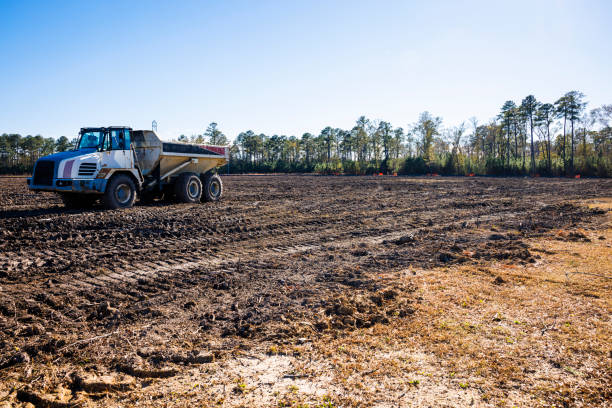Land Grading: A Crucial Step in Site Development and Construction
Land grading is an essential process in site development and construction, playing a crucial role in shaping the land to ensure it’s suitable for building, landscaping, and infrastructure development. Whether you're preparing a plot for a new residential property, commercial development, or agricultural project, proper grading ensures that the land is level, stable, and prepared for future construction. It’s a process that directly impacts the longevity and safety of the structure being built, as well as the overall functionality of the land.
What is Land Grading?
Land grading is the process of leveling or reshaping the land to create a smooth, stable surface. This process ensures that the land is properly sloped to facilitate proper drainage, avoid water pooling around buildings, and prevent erosion. The goal of grading is to create an even, firm foundation for construction, as well as to shape the terrain for landscaping or infrastructure projects.
While grading primarily focuses on leveling the ground, it can also involve reshaping the terrain to achieve specific slopes or elevations. The land may need to be raised or lowered, depending on the desired outcome, and grading is crucial to avoid structural damage caused by poor water flow or uneven ground.
Why is Land Grading Important?
Land grading is important for several reasons, particularly in construction and land development. Proper grading ensures:
1. Proper Drainage
Proper grading helps water flow away from buildings and foundations, preventing flooding and water damage. Without grading, water could pool around the foundation, leading to erosion, cracking, and structural instability over time. A well-graded site ensures that water flows away from key areas, protecting the integrity of the structure and the surrounding landscape.
2. Foundation Stability
For any construction project, the stability of the foundation is critical. Land grading creates a level and stable surface, preventing issues like uneven settling or foundation cracks. Grading also helps ensure that the foundation is built on solid ground, reducing the risk of structural problems down the line.
3. Prevention of Soil Erosion
Grading helps to land grading soil erosion by creating proper slopes and ensuring that water runoff is directed away from sensitive areas. This is especially important for agricultural projects and areas with loose or sandy soil. Without proper grading, soil can wash away, leading to the loss of valuable topsoil and compromising land fertility.
4. Improved Landscaping
Grading plays a significant role in landscaping by creating slopes for garden beds, outdoor features, and lawns. Proper grading also ensures that landscaping elements like trees, ponds, and water features are positioned correctly, providing both aesthetic appeal and functionality.
5. Compliance with Local Regulations
Many local building codes and zoning laws require specific grading conditions to ensure that construction projects are safe and meet environmental standards. Grading ensures that a site complies with these regulations, such as stormwater management and erosion control measures, before construction begins.
Types of Land Grading
Land grading can be broadly divided into two categories: rough grading and finish grading. Each type serves a different purpose and is carried out at different stages of a project.
1. Rough Grading
Rough grading involves the initial reshaping of the land. It’s the first step in the grading process and is typically done after land clearing. The goal of rough grading is to create a general slope and remove large obstructions, like rocks, large roots, or uneven soil. During rough grading, the land may be cut or filled to achieve the desired elevation and contour.
Rough grading usually includes:
- Cutting: Removing soil or rock from higher areas to create a lower, more level surface.
- Filling: Adding soil to lower areas to raise them to the desired level.
- Establishing slopes: Creating the initial slopes to guide water away from structures or areas prone to water accumulation.
Rough grading sets the stage for the more detailed and precise finish grading that will follow.
2. Finish Grading
Finish grading is the final step in the grading process and involves fine-tuning the land to create an even, smooth surface that is ready for construction or landscaping. The goal of finish grading is to ensure that the site is level, with specific slopes where necessary, and that it meets all the design requirements for the project.
Finish grading includes:
- Smooth leveling: Making sure the surface is even and uniform, eliminating any bumps, depressions, or uneven areas.
- Final slope adjustments: Ensuring the land slopes properly for drainage, typically with a slight slope away from the building or key infrastructure areas.
- Soil compaction: Compacting the soil to make it stable and ready for construction or landscaping. Proper compaction prevents soil settling, which could damage structures over time.
Finish grading is critical to ensure that water doesn’t accumulate in unwanted areas and that the land is perfectly prepared for the next steps in development.
Steps in the Land Grading Process
The land grading process typically follows a series of steps to ensure proper leveling and shaping of the site. These steps are carried out in sequence to achieve the desired result.
1. Site Assessment and Surveying
Before grading can begin, a thorough assessment of the land must be conducted. This involves surveying the site to measure its topography, determine the elevations, and identify any existing drainage issues. Site surveys also include identifying existing structures, property lines, and underground utilities to avoid any disruptions during the grading process.
2. Land Clearing
Once the survey is completed, land clearing is the first physical step in grading. This involves removing trees, vegetation, debris, and any old structures that might interfere with grading or construction. The cleared land is now ready for the grading equipment to begin reshaping the surface.
3. Excavation and Earthmoving
After clearing, excavation begins to move soil or rock as needed to achieve the desired contour and elevation. This step may involve using excavators, bulldozers, and other earth-moving equipment to cut into high areas or fill low areas. Depending on the scope of the project, large quantities of soil may need to be moved, requiring heavy machinery.
4. Rough Grading
Rough grading follows excavation and involves creating a general slope and adjusting the land’s elevation to prepare for finish grading. This step may include adding or removing soil, depending on the natural contours of the land and the project’s requirements.
5. Finish Grading
Finish grading is the most precise part of the process, ensuring that the land is smooth, level, and properly sloped. This step may involve smoothing out soil using grading machines, compacting the soil, and ensuring that drainage is properly directed away from structures. This final layer of grading ensures that the land is prepared for construction or landscaping.
6. Compaction and Stabilization
Once grading is completed, soil compaction is necessary to stabilize the ground and prevent future settling. Proper compaction is crucial to ensure that the land can support heavy structures like buildings or roads. It also helps prevent soil erosion and maintains the integrity of the grading work over time.
Equipment Used in Land Grading
Land grading requires specialized equipment to handle the heavy-duty tasks of excavation, leveling, and compaction. Common equipment used includes:
- Bulldozers: Powerful machines with a large blade used to move and level large quantities of soil.
- Excavators: Large machines used to dig and move earth, typically used for deep excavation or trenching.
- Graders: Machines used for fine leveling and smoothing the surface to ensure the ground is even and precise.
- Skid-Steer Loaders: Compact machines used for grading smaller areas and moving dirt in tight spaces.
- Rollers and Compactors: Used to compress soil and ensure that it is stable and compacted before construction.
Conclusion
Land grading is a crucial step in the preparation of any construction project, ensuring that the site is level, stable, and well-drained. Whether you are preparing land for residential, commercial, or agricultural purposes, proper grading provides the foundation for safe, successful development. From rough grading to finish grading, each step ensures that the land is shaped to meet the specific requirements of the project, helping to prevent long-term issues like erosion, flooding, or foundation problems.
By using the right equipment and techniques, land grading ensures that your construction site is ready for the next phase of development, whether that involves laying the foundation, installing utilities, or landscaping the property. Investing in high-quality grading services is a vital part of any construction project, setting the stage for a safe, durable, and functional structure.

回答
まだコメントがありません

新規登録してログインすると質問にコメントがつけられます